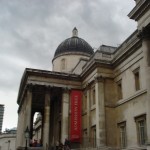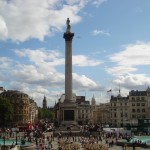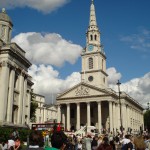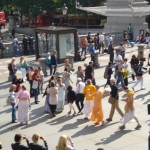September 15th, 2009 · 2 Comments
I have lost count of the number of churches in London. Yet, I would not be surprised if there were double (or triple) the number of churches I have seen in the city. Though numerous, I have not yet found a church packed with a local (or visiting) congregation. Sundays, according to tradition, mark the closing of many stores, leaving most streets barren and still. Though Sunday marks a day of rest in the United States as well, one essential difference remains – massive crowds can be seen going to pray at their respective place of worship. (I will mention here that Sunday is not the most important day of the week for many other religions. For the purpose of this post, I will remain largely within the Christian faith, which marks Sunday as a holy day or, at the very least, a day of worship.)
So, the expression “Put on your Sunday best” may not directly apply to my encounters with British Christians. I cannot speak at length to the prevalence of secularism in the country, but from my reading (see the BBC’s site on Athiesm here; see the National Secular Society homepage here) I can note its prevalence in the country. Even our tour guide noted at one point in his presentation of Westminster Abbey that the British are much less religious than Americans.
Regardless, I have come face-to-face with churches and cathedrals – sprawling and small, centuries-old and recently renovated. I have about 40 pictures of churches taken from the same angle looking upwards at the columns or Gothic style or high steeples that sweep the façade of these buildings. One that grasps my general impression of churches in Britain (thus far) could be St. Martin-in-the-Fields. Though the primary reason for visiting the church was to see the E.L.F. Trio, I was immediately impressed by the simple yet elegant design of the building. This was before our visit to Westminster Abbey or St. Paul’s, mind you, so my impression of London’s churches was limited. I remained thoroughly impressed with the church until we went into the crypt. What some consider a modernization of the crypt, I immediately saw as a cheapening injustice to the integrity of that part of the building. As a person of another faith, I was shocked. As a History major, I was appalled. As a tourist who had been in London less than a week, I could not have been more surprised.
I saw tomb markers dating from the 18th century, faded and worn down to bare stone. Well, I should say this carefully, for I did not see all of the tomb markers, for steel chairs and tables prevented me to see many of them fully. The church has recently converted the crypt into a Café in the Crypt – a restaurant that provides a true British dining experience among the dead buried throughout the building’s history. (For music connoisseurs, try out the British jazz scene at the church’s “Jazz Night” in the Café in the Crypt.)
Something about seeing this crypt transformed into a tourist attraction bothered me, but I am not sure if I really have a legitimate reason. (I am a history major, so I would rather see these stones preserved, for instance.) By the same token, I understand that the church has undergone a massive renovation project (which continues to this day) in order to bring new life to the building. It remains a symbol of charity, community, and worship to many people – religious or otherwise. I understand this…yet I would still rather see a commemoration of the people who were buried in the crypt rather than an art display or a jazz musician.
Reading Peter Ackroyd’s thoughts on churches in the city in London: The Biography brings some better understanding to the subject. He describes, in part, neighboring Westminster Abbey as a “city of the dead” (39) and as a monument. The nature of Christianity has changed in London, he argues, and is not as fervent as it was at other points in the city’s history. It is not “lost,” however, for though holy sites across London have been transformed, destroyed, or renovated, they can never really lose their history as holy places (40-43).
I may never get used to the notion of flinging an identifying feature of a place of worship (e.g. a crypt) into the 21st century. Of greater relevance, I do not think I can quickly agree that, as Ackroyd argues, only the face of these sites changes, leaving the heart of the holy site intact. Since visiting the church, I can begin to appreciate their efforts to provide for the surrounding community some other outlet besides worship – such as music and art venues. St Martin-in-the-Fields does plenty of good for the surrounding community, and I would be interested to see how this project succeeds in continuing this tradition.

Tags: Brandon
August 26th, 2009 · Comments Off on Light Sounds
Light – unnatural light from the hulking, undoubtedly gilt chandeliers and natural light which poured in through massive, paned windows – set a noonday glow upon the carved stone walls of Saint Martin in the Fields yesterday. The same light spilled onto the crowd that had gathered to watch the performance. For a donation of a few pounds – or nothing, if one desired – appreciators of music of all ages had the opportunity to attend a performance by E.L.F., a trio comprised of a pianist, flautist, and horn player.
The three are known for their versatility, playing anything and everything from classical and pop music to arrangements from soundtracks and musical scores. At St. Martin in the Fields yesterday, E.L.F. stayed true to their reputation, playing a variety of pieces, but none nearly as powerful and interesting as Phantasia, based on Andrew Lloyd Weber’s famous The Phantom of the Opera. E.L.F.’s interpretations of hit songs such as “Music of the Night,” “Past the Point of No Return,” “Masquerade,” “All I Ask of You” and, of course, “Phantom of the Opera” were unexpected and enjoyable. Tempos were adjusted, notes and rests altered to create surprising syncopation, harmonies and jarringly dissonant chords created where none existed previously. At one point during the piece, “All I Ask of You,” a deeply emotional – and during the reprise, truly painful – love song segwayed beautifully into “Masquerade,” a joyful song with an element of whimsy. The transition was unexpected, but surprisingly appropriate and effective.
What else I found to be especially inspiring was the obvious love of the art felt by the performers and the flautist in particular. Even when he was not playing, the flautist made eye contact with his fellow members, smiled, rocked and tapped and swooshed to be beat – or off-beat – of the music, as if all the nerves in his body were firing and playing their own fleshy instruments rather than the flute lying in anticipation at his side.
The light glanced off of the musicians’ instruments as they walked off and bowed to the crowd. The light burned my eyes as I left bliss inside St. Martin in the Fields and walked out into the crush of humanity that is Trafalgar Square. The light left shadows under my feet.

Tags: Anya · Churches and Cathedrals
On our way yo St. Martin in the Field we ran into an wonderful violinist in the Tube. Each of us in the group dropped some of our excess change into his violin case and went on our way. At that point we did not realize what was waiting for us at St Martin’s. After taking our seats the E.L.F. Trio began to play and all of us were completely blown away! I find it mind boggling that such an AMAZING concert could be free open to the public.
We then all headed over to the National Gallery. The National Gallery was also free, so we all got to see Rubens, Di Vinci, Turner (my favorite), Monet, and Van Gogh for FREE. The longer I am here the more I am impressed by the extent to which London embraces and supports the arts. There are free concerts everywhere, all the time, and extrordinary people simply playing in the street or in the Tube. I would move here in an instant, if givin the chance and lets face it the finances, simply for the arts.
Tags: Rebecca
Today’s class centered around a discussion of how immigrant and minority populations in London have either struggled or been able to assimilate. We examined specific groups and religions and attempted to define exactly what assimilation entails. Kelley brought up a great point about how some groups that come to London have no interest in assimilation. They come simply to get an education, make some money and share what they’ve learned once they return to their country of birth. This complicates the assimilation process even more. What can we do as educated young people to help minority groups achieve assimilation? Do they want our help at all? These are some questions I am going to continue to wrestle with for the remainder of my time in the U.K.
After class today I had an afternoon filled with art, both musical and visual. A lunchtime concert at historic St. Martin in the Fields featured a fantastic three man ensemble called E.L.F. Made up of a pianist Geoff Eales, french horn player Dave Lee and flautist Andy Findon the group put on an incredible performance highlighted by an extraordinary 40 minute take on Andrew Lloyd Webber’s “The Phantom of the Opera”. The music was moving and captivating throughout and at the end of “All I Ask of You” I was left with goosebumps from head to toe. As someone who played trumpet and a little bit of French Horn throughout high school I was amazed by the richness of the sound Mr. Lee produced. It was superior to anything I had ever heard performed in the past. The church’s incredible acoustics certainly had a major impact on the groups resounding sound as well turning a three man ensemble into what sounded like a full fledged orchestra. One action that took place during the concert that Brandon and I were pondering was whether it is customary for performers to exit the stage completely while the audience applauds and then return for the next number shortly after. We were unsure if this was something unique to England, unique to St. Martins in the Fields or whether the group chose to do so at their own discretion. In any event it was something we had never seen before.
After the concert Aidan, Brandon and I headed over to the National Gallery where we gazed at thousands of works of art from all different countries and time periods. I do not know much about visual art and what techniques are used to make paintings considered great but I was continually amazed and impressed by the amount of detail these artists put into their work. Even the smallest stroke of a paintbrush can change a painting entirely. We spent a number of hours inside the National Gallery gazing at everything from Van Gogh to Manet to Van Brugh. Visual art is not my forte nor my specialty but I was very impressed and would go back to the museum in a heartbeat.
After our tour of the National Gallery we headed back out to Trafalgar Square. The rain had let up and the square was alive with all kinds of people. There was protesting, dancing, singing and any number of exciting things going on. We took an abundance of pictures while in the area, attempting to catch all the excitement that was taking place as well as capturing the various monuments in the area such as Nelson’s Column and St. Martin in the Fields.
The final stop in our afternoon included a tour of the National Portrait Gallery, just down the road from St. Martin in the Fields. Inside we viewed portraits of everyone from Princess Diana to T.S. Eliot. My favorite part of the portrait gallery was the section they featured on the Bloomsbury Group. Portraits of Virginia Woolf, E.M. Forster and Lytton Strachey just to name a few were found inside this area. After going on the Bloomsbury walk the day before with Professor Qualls the information was still fresh in my mind and I was able to make connections between the tour and the exhibit. This was fascinating.
I can safely say that this has been my favorite day in London so far. A stimulating discussion, an unbelievable concert, a walk through an internationally recognized museum and time spent with friends adds up to a wonderful and busy day. I hope that the rest of our time spent in London will follow suit.
Tags: Churches and Cathedrals · Henry · Museums






